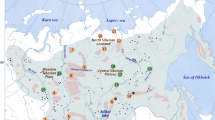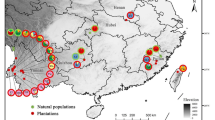Abstract
Acacia sciophanes is an extremely rare and Critically Endangered species known from two small populations separated by less than 7 km. Specifically we aimed to investigate whether rarity in A. sciophanes is associated with decreased levels of genetic variation and increased levels of selfing by comparing patterns of genetic variation and mating system parameters with its widespread and common sister species A. anfractuosa. Fourteen polymorphic allozyme loci were used to assess genetic diversity with four of these used in the estimation of mating system parameters. At the species level A. sciophanes has lower allelic richness, polymorphism, observed heterozygosity and gene diversity than A. anfractuosa and significantly lower levels of gene diversity at the population level. Both species have a mixed mating system but the largest population of A. sciophanes has lower levels of outcrossing, higher correlated paternity and increased bi-parental inbreeding compared with two A. anfractuosa populations. However, both correlated paternity and bi-parental inbreeding appear to be at least partly influenced by population size regardless of the species. We suggest that A. sciophanes is likely to be an intrinsically rare species and that in particular the lower levels of genetic diversity and increased selfing are a feature of a species that has the ability to persist in a few localised small populations. Despite recent extensive habitat destruction our comparative study provided no clear evidence that such events have contributed to the lower genetic diversity and increased selfing in A. sciophanes and we believe its ability to exist in small populations may not only be an important factor in its survival as a rare species but also indicates that it may be less susceptible to the impacts of habitat loss and fragmentation. The key to this species conservation will be the maintenance of suitable habitat, particularly through improved fire regimes and control of invasive weeds, that will allow the two small populations to continue to persist in extremely restricted areas of remnant vegetation.
Similar content being viewed by others
References
Barrett SCH, Kohn JR (1991) Genetics and evolutionary consequences of small population size in plants: implications for conservation. In: Falk DA and Holsinger KE (eds) Genetics and Conservation of Rare Plants. Oxford University Press, New York, pp. 3–30
Bernhardt P, Kenrick J, Knox RB (1984) Pollination biology and the breeding system of Acacia retinodes (Leguminosae:Mimosoideae). Ann. Missouri Bot. Gard. 71:17–29
Broadhurst LM, Coates DJ (2002) Genetic diversity within and divergence between rare and geographically widespread taxa of the Acacia acuminata (Mimosaceae) complex. Heredity 88:250–257
Brown AHD, Allard RW (1970) Estimation of the mating system in open pollinated maize populations using allozyme polymorphisms. Genetics 66: 133–145
Buist M, Coates DJ, Yates C (2002) Rarity and threat in relation to the conservation of Acacia in Western Australia. Conserv. Sci. Western Australia 4: 36–53
Byrne M, Macdonald B, Coates DJ (2002) Phylogeographical patterns in chloroplast DNA variation within Acacia acuminata (Leguminosae: Mimosoidae) complex in Western Australia. J. Evol. Biol. 15: 576–587
Byrne M, Tischler G, Macdonald G, Coates DJ, McComb JA (2001) Phylogenetic relationships between two rare acacias and their common, widespread relatives in south-western Australia. Cons. Gene. 2: 157–166
Carr DE, Dudash MR (2003) Recent approaches into the genetic basis of inbreeding depression in plants. Phil. Trans. R. Soc. Lond. B 358:1071–1048
Casiva PV, Vilardi JC, Cialdella AM, Saidman BO (2004) Mating system and population structure of Acacia aroma and A. macracantha (Fabaceae). Am. J. Bot. 91: 58–64
Coates DJ (1988) Genetic diversity and population structure in the rare Chittering grass wattle, Acacia anomala. Aust. J. Bot. 36: 273–286
Coates DJ, Carstairs S, Hamley VL (2003) Evolutionary patterns and genetic structure in localized and widespread species in the Stylidium caricifolium complex (Stylidiaceae). Am. J. Bot. 90: 997–1008
Cole TC (2003) Genetic variation in rare and common plants. Annu. Rev. Ecol. Evol. Syst. 34: 213–237
Cornuet JM, Luikart G (1996) Description and power analysis of two tests for detecting recent population bottlenecks from allele frequency data. Genetics 144: 2001–2014
Ellestrand NC, Elam DR (1993) Population genetic consequences of small population size: implications for plant conservation. Annu. Rev. Ecol. Syst. 24: 217–242
Elliott C, Yates CJ, Ladd PG, Coates DJ (2002) Morphometric, genetic and population studies used to clarify the conservation status of a rare Acacia in Western Australia. Aust. J. Bot. 50:53–73
Evans R, Phillimore R, Brown A (2000) Wundowlin wattle (Acacia sciophanes) Interim Recovery Plan 2000–2003. Department of Conservation and Land Management, Perth, Western Australia
Felsenstein J (1995) PHYLIP (Phylogeny Inference Package), version 3.5c. http://www.evolution.genetics.washington.edu/phylip.html
Fiedler PL, Ahouse JJ (1992) Hierarchies of cause: toward an understanding of rarity in vascular plant species. In: Fiedler PL, Jain SK (eds) Conservation Biology. Chapman and Hall, New York, USA, pp. 23–48
Ge S, Wang KQ, Hong DY, Zhang WH, and Zu YG (1999) Comparisons of genetic diversity in the endangered Adenophora lobophylla and its widespread congener, A. potaninii. Conserv. Biol. 13: 509–513
Gitzendanner MA, Soltis PS (2000) Patterns of genetic variation in rare and widespread congeners. Am. J. Bot. 87: 783–792
Godt MJW, Hamrick JL (1999) Genetic divergence among infraspecific taxa of Sarracenia purpurea. Syst. Bot. 23: 427–438
Gottleib LD (1981) Electrophoretic evidence and plant populations. Prog. Phytochem. 7: 1–45
Hamrick J.L, Godt MJW (1989) Allozyme diversity in plant species. In: Brown ADH, Clegg MT, Kahler AL, Weir BS (eds) Plant Population Genetics, Breeding and Genetic Resources. Sinauer Associates, Sunderland, Massachusetts, USA, pp. 43–63
Hamrick J.L, Godt MJW, Sherman-Broyles SL (1992) Factors influencing levels of genetic diversity in woody plant species. New Forests 6: 95–124
Hopper SD (1979) Biogeographical aspects of speciation in the southwest Australian flora. Annu. Rev. Syst. Ecol., 10, 399–422
Hopper SD (1992) Patterns of plant diversity at the population and species levels in south-west Australian mediterranean ecosystems. In: Hobbs RJ (eds) Biodiversity of Mediterranean Ecosystems in Australia. Surrey Beatty and Sons, Chipping Norton, NSW Australia, pp. 27–46
Karron JD (1987) A comparison of levels of genetic polymorphism and self-compatibility in geographically restricted and widespread plant congeners. Evol. Ecol. 1: 47–58
Karron JD (1991) Patterns of genetic variation and breeding systems in rare plant species. In: Falk DA, Holsinger KE (eds) Genetics and Conservation of Rare Plants. Oxford University Press, New York, New York, USA, pp. 87–98
Kenrick J, Knox RB (1989) Quantitative analysis of self incompatibility in trees of seven species of Acacia. J. Hered. 80: 240–245
Kenrick J, Kaul V, Williams EG (1986) Self-incompatibility in Acacia retinodes: site of pollen tube arrest is the nucellus. Planta 169: 245–250
Loveless MD, Hamrick JL (1988) Genetic organization and evolutionary history in two American species of Cirsium. Evolution 42: 254–265
Luikart G, Cornuet JM (1998) Empirical evaluation of a test for identifying recently bottlenecked populations from allele frequency data. Conserv. Biol. 12: 228–237
Maslin BM (2001) The role and relevance of taxonomy in the conservation and utilization of Australian Acacias. Conserv. Sci. Western Australia 4: 1–9
McGranahan M, Bell JC, Moran GF, Slee M (1997) High genetic divergence between geographic regions in the highly outcrossing species Acacia aulacocarpa Cunn. ex Benth. For. Genet. 4: 1–13
Moran GF, Muona O, Bell JC (1989a) Breeding systems and genetic diversity in Acacia auriculiformis and A. crassicarpa. Biotropica 21: 250–256
Moran GF, Muona O, Bell JC (1989b) Acacia mangium: a tropical forest tree of the coastal lowlands with low genetic diversity. Evolution 43: 231–235
Morgan A, Carthew SM, Sedgley M (2002) Breeding system, reproductive efficiency and weed potential of Acacia baileyana. Aust. J. Bot. 50: 357–364
Nei M (1978) Estimation of average heterozygosity and genetic distance from a small number of individuals. Genetics 89:583–590
Piry S, Luikart G, Cornuet JM (1999) BOTTLENECK: a computer program for detecting recent reductions in the effective size using allele frequency data. J. Hered. 90: 502–503
Playford J, Bell JC, Moran GF (1993) A major disjunction in genetic diversity over the geographic range of Acacia melanoxylon R. Br. Aust. J. Bot. 41: 355–368
Rabinowitz D (1981) Seven forms of rarity. In: Synge H (eds) The Biological Aspects of Rare Plant Conservation. John Wiley and Sons, Chichester, UK, pp. 205–217
Ritland K (1989) Correlated matings in the partial selfer, Mimulus guttatus. Evolution 43: 848–859
Ritland K (2002) Extension of models for the estimation of mating systems using n independent loci. Heredity 88: 367–368
Ritland K, Jain S (1981) A model for the estimation of outcrossing rate and gene frequencies using n independent loci. Heredity 47:35–52
Searle SD, Bell JC, Moran GF (2000). Genetic diversity in natural populations of Acacia mearnsii. Aust. J. Bot. 48: 279–286
Weir BS (1996) Genetic data analysis II. Sinauer Associates, Sunderland, USA
Wright S (1978) Evolution and the Genetics of Populations, Vol. 4, Variability Within and Among Natural Populations. University of Chicago Press, Chicago
Yates CJ, Broadhurst LM (2002) Assessing limitations on population growth in two critically endangered Acacia taxa. Biol. Cons. 108: 13–36
Yeh FC, Boyle TJB (1997) POPGENE Version 1.20, http://www.ualberta.ca/∼ ∼fyeh/
Young AG, Brown AHD (1996) Comparative population genetic structure of the rare woodland shrub Daviesia suaveolens and its common congener D. mimosoides. Conserv. Biol. 10: 374–381
Young AG, Brown AHD (1998) Comparative analysis of the mating system of the rare woodland shrub Daviesia suaveolens and its common congener D. mimosoides. Heredity 80: 374–381
Young AG, Boyle T, Brown AHD (1996) The population genetic consequences of habitat fragmentation for plants. Trends Ecol. Evol. 11: 413–418
Acknowledgements
We thank Bruce Maslin for advice and assistance in the field, and Department of Conservation and Land Management Merredin District staff for their support during field collections and population details regarding the conservation status of A. sciophanes.
Author information
Authors and Affiliations
Corresponding author
Rights and permissions
About this article
Cite this article
Coates, D.J., Tischler, G. & McComb, J.A. Genetic variation and the mating system in the rare Acacia sciophanes compared with its common sister species Acacia anfractuosa (Mimosaceae). Conserv Genet 7, 931–944 (2006). https://doi.org/10.1007/s10592-006-9136-7
Received:
Accepted:
Published:
Issue Date:
DOI: https://doi.org/10.1007/s10592-006-9136-7




